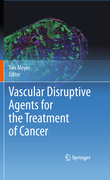
Tumour survival and growth is critically dependent on an independent blood supply. As such tumour vasculature presents an ideal target for cancer therapy that is widely applicable, accessible and genetically stable rendering it less prone to resistance. Two approaches have been explored for cancer therapy; firstly the prevention of new vessel formation with inhibitors of angiogenesis, and secondly the destruction of existing tumour blood vessels with so called vascular disruptive agents (VDAs). While the first approach appears to delay tumour progression, the second has the potential to cause massive cell death and tumour regression. It si the second approach of vascular targeting that is thefocus of this review. Since the tubulin binding agent combretastatin, derivedfrom the bark of the African bush willow, was discovered by George R Pettit to have antimitotic properties over twenty years ago, the field of vascular targeting has expanded steadily. Coincident with the preclinical and clinical development of these agents, there have been advances in our understanding of their mechanism of action and in the technology required to assess their effects.This book discusses preclinical target identification and validation, and theoptimum pre-clinical animal models Biomarkers and imaging modalities used to assess the efficacy of these agents are examined A review of the clinical development of key drugs is provided Recent research exploring rational combinations of VDAs with other agents is reviewed and the potential place of VDAs in the future of cancer therapy is critically appraised INDICE: Introduction D Chaplin/ GR Pettit.- Pre-clinical development.- Target identification D Neri/A Harris.- Animal models RB Pedley/ G Tozer.- Combination therapy R Giavazzi / R Kerbel.- Biomarkers.- MRI A Padhani.- CT E Aboagye.- Ultrasound R Brekken.- Circulating endothelial cells F Bertolini.- Circulating tumour cells.- Serum markers.- Clinical development .- Combretastatin G Rustin.- DMXAA B Baguley.- Other agents .- Combination therapy Siemann D.- Conclusion.
- ISBN: 978-1-4419-6608-7
- Editorial: Springer
- Encuadernacion: Cartoné
- Páginas: 200
- Fecha Publicación: 29/09/2010
- Nº Volúmenes: 1
- Idioma: Inglés
